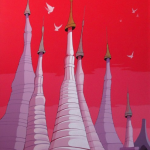The Irrawaddy Magazine |
- KNPP Mulls Army’s Request to Question Alleged Witness to Executions
- Myanmar-China-Singapore Consortium Wins Yangon Central Railway Bid
- Experts to Research Mt. Popa Landslides Over Safety Concerns
- Artist Doesn’t Hesitate to Change the World With Her Brushes
- Myanmar Policeman Who Detained Reuters Pair “Did Not Know Arrest Procedures”
- China Reports First Human Case of H7N4 Bird Flu
- International Community Fails to See Myanmar for What It Is
| KNPP Mulls Army’s Request to Question Alleged Witness to Executions Posted: 15 Feb 2018 05:46 AM PST YANGON — The Karenni National Progressive Party (KNPP) says it is considering a request from the Myanmar military, or Tatmadaw, to question a member of the group’s armed wing who claims to have seen government troops execute four people in Karenni State in December. The KNPP claims that Tatmadaw soldiers executed three of its fighters and a civilian when they raided the ethnic armed group’s base in Loikaw Township on Dec. 20. The Tatmadaw has claimed that the four were killed in a firefight during the raid but has formed a special commission to investigate the deaths and is seeking the alleged witness’ testimony. "They want to hear from him. They want his testimony for their investigation," said Khu Daniel, a member of the KNPP’s central committee. "We will make a decision after we are able to meet with the government and the NRPC," he added, referring to the government-run National Reconciliation and Peace Center The KNPP says it has already asked the government and NRPC for a meeting to discuss the deaths and the broader peace process and was still waiting for a reply. According to the KNPP, Maung Lar, a member of its armed wing, witnessed the executions and managed to escape. At a press conference in Loikaw in late December, the KNPP played what it said was a recording of Maung Lar. The man in the recording says the Tatmadaw soldiers, after raiding the armed group’s base, told him and the other four to line up for a photo but started shooting them instead and that he only just managed to run away. The KNPP and other local sources say the Tatmadaw has sent an investigating team from Naypyitaw to Loikaw three times already and met with people living near the scene of the alleged crime during its last visit earlier this month. The team includes four members of the Tatmadaw’s top military court and a colonel from its Eastern Command base in Shan State. "They told us they would investigate first, then take the case to court, then take action,” Khu Daniel said. “The investigation team even told us that if they found rights violations they would take action according to the rule of law. They even gave us the example of how they took action against their soldiers in the Kachin case," he said. A military court sentenced six soldiers to 10 years in prison last month for killing three Kachin men from a camp for internally displaced people in Mansi Township. The KNPP says it has asked the Tatmadaw for a joint investigation, but so far to no avail. Khu Daniel said the party was worried for Maung Lar’s safety if he were to meet with the Tatmadaw. "He is the most important person as the eye witness, so we are worried he might disappear. We will let them see him when we feel the conditions for him are safe and secure,” he said. The post KNPP Mulls Army’s Request to Question Alleged Witness to Executions appeared first on The Irrawaddy. |
| Myanmar-China-Singapore Consortium Wins Yangon Central Railway Bid Posted: 15 Feb 2018 04:05 AM PST YANGON — A consortium including a Singapore-listed company has won the bidding for the Yangon Central Railways Station Area Comprehensive Development Project, Myanma Railways said. The consortium comprises Myanmar's Min Dharma Co, China's Sino Great Wall Co, and Singapore-based property developer Oxley Holdings Limited. The mixed-development project comprises a new central transportation hub integrating rail and mass transit, surrounded by residential and commercial properties. It will occupy 25.7 hectares, with total floor space for development of 1.09 million sq. m, Oxley Holdings said. Awarding of the contract is subject to the completion of negotiations and legal arrangements, Myanma Railways said. Sino Great Wall is a Beijing-based company listed on the Shenzhen Stock Exchange. Min Dharma Co is a subsidiary of Mottama Holdings owned by Chinese-Myanmar businessman Yang Ho. Illustrations provided by Oxley Holdings show high-rise buildings bordered by Bogyoke Aung San Road to the south, Bo Min Yaung Road to the north, Sule Pagoda Road to the west and Theinbyu Road to the east. The post Myanmar-China-Singapore Consortium Wins Yangon Central Railway Bid appeared first on The Irrawaddy. |
| Experts to Research Mt. Popa Landslides Over Safety Concerns Posted: 15 Feb 2018 03:44 AM PST MANDALAY — Research to investigate, prevent and secure a reactivated landslide in the Mt. Popa area is set to begin at the end of this month, according to experts. The research plan, organized by the Mandalay regional government, follows significant landslides that occurred in October 2017 in the region. "We are going to dig holes to investigate the soil and water drainage situation. Afterwards, we will survey land movement rates," said Dr. Soe Moe Kyaw Win, an engineering geologist and member of the research team. According to experts, the landslides began some 20 years ago, however, they have become more sizeable in recent years. In October 2017, the road at the foot of the Mt. Popa volcanic plug sunk about three feet, and the area faced landslides that damaged or destroyed nearby buildings. Mount Popa is an extinct volcano that rises 1518 meters above sea level. Locals regard it as a religious center and the site of the 37 Great Nats—ancient animist spirits. According to experts, the landslides are due to natural causes, but human elements are worsening the situation. "Construction sometimes blocks underground waterways, which can worsen landslides if neglected," said Dr. Soe Moe Kyaw Win. "However, we are not saying buildings need to be moved. After researching the situation, we hope to provide a solution that will safeguard locals and prevent disaster," he added. The experts said the team would collaborate with regional government officials to educate locals following their research. According to the local authorities, no actions have yet been taken to move any local buildings. "We have carried out preliminary awareness campaigns for locals. We are waiting for the research before issuing further safety considerations," said U Aye Khine, a local lawmaker and the President of the Popa Lovers Association. The post Experts to Research Mt. Popa Landslides Over Safety Concerns appeared first on The Irrawaddy. |
| Artist Doesn’t Hesitate to Change the World With Her Brushes Posted: 14 Feb 2018 11:37 PM PST Despite her name—that can be translated into English as tenderness—Nu Nu is a brave woman when it comes to painting. She is never hesitant to change the world with her brushes. Last year, she visited Shan State's renowned Inle Lake. On her return to Yangon, she has put her memories of the lake on canvas. Those paintings will be showcased at what she has called the 'Sweet Inle' exhibition from Feb. 17-21 at 43 Art Gallery on 43rd Street in Yangon's Botahtaung Township.  Nu Nu was destined to lead the life of an artist, being born to her father, the distinguished watercolor artist U Mya Thaung, and having married celebrated artist Ye Aung Myat. They all have different styles but make suggestions and influence each other, said Nu Nu. Her paintings depict landscapes, buildings, pagodas and stupas around Inle Lake in different colors and perspectives. "I visited Inle in 2014 and 2017. I created the paintings based on the photos I took and my imagination. Mainly, designs and colors distinguish my paintings," said Nu Nu.  Nearly 30 paintings will be showcased at the exhibition and can be purchased for prices between US$180 and $1,800. Nu Nu graduated with a degree in painting from the National University of Arts and Culture in 1999 and has held four solo shows and participated in dozens of art exhibitions. Sweet Inle is her fifth solo exhibition. "I invite my teachers, friends and relatives to come and see my paintings," said Nu Nu. The post Artist Doesn't Hesitate to Change the World With Her Brushes appeared first on The Irrawaddy. |
| Myanmar Policeman Who Detained Reuters Pair “Did Not Know Arrest Procedures” Posted: 14 Feb 2018 09:37 PM PST YANGON — A police officer who said he was part of the team that detained two Reuters reporters in Myanmar in December told a court on Wednesday that he was not familiar with police procedures for recording arrests. Second Lieutenant Myo Ko Ko was the latest prosecution witness to give evidence in proceedings to decide whether reporters Wa Lone, 31, and Kyaw Soe Oo, 27, should be charged under Myanmar’s colonial-era Official Secrets Act. Defense lawyer Khin Maung Zaw told reporters after the hearing that Myo Ko Ko had conceded during cross-examination that he was not familiar with procedural rules in Myanmar’s police manual. “So he cannot be a reliable witness for the prosecution,” Khin Maung Zaw said. Wa Lone and Kyaw Soe Oo were arrested on Dec. 12 for allegedly obtaining confidential documents, after they had been invited to meet police officers over dinner in Yangon. The pair have told relatives they were arrested almost immediately after being handed some papers at a restaurant by two officers they had not met before. Asked about the location where the arrests took place, Myo Ko Ko said it was on a street lined by factories. That contradicted a map previously produced by police and entered in the court file, which showed stores and tea shops, but no factories. Myo Ko Ko told the court he was part of the arresting team, but did not see the documents police have said the two reporters were holding in their hands. At a previous hearing, police Major Min Thant had agreed during cross-examination that the information in the documents that Wa Lone and Kyaw Soe Oo were holding had already been published in newspaper reports. Earlier in Wednesday’s proceedings the prosecution had opposed a defense request that the police station logbook in which the arrests had been recorded should be shown to the court as evidence, arguing that it was still in daily use and could not leave the police station. Judge Ye Lwin refused the defense’s request, saying the defense did not have the right to see the record at this stage of the proceedings. Mass Grave Report The two reporters had been working on a Reuters investigation into the killing of 10 Rohingya Muslim men who were buried in a mass grave in northern Rakhine State after being hacked to death or shot by ethnic Rakhine Buddhist neighbors and soldiers. After Reuters published its report on the killings on Feb. 8, calls have mounted for the release of the two reporters. The United States said at a meeting of the UN Security Council on Tuesday that Myanmar had “the gall to blame the media” for the situation in Rakhine and demanded that the reporters be freed. “For the crime of reporting the truth, the Burmese (Myanmar) government arrested and imprisoned the reporters,” said Nikki Haley, U.S. ambassador to the United Nations. “Unhindered media access is vitally important. Journalists like the two imprisoned Reuters reporters are an indispensable source of information.” Britain, France, the Netherlands and Kazakhstan also called at the meeting for the release of the reporters. Myanmar UN Ambassador Hau Do Suan said Myanmar recognizes freedom of the press and the journalists were not arrested for reporting a story, but were accused of “illegally possessing confidential government documents." Nearly 690,000 Rohingya have fled Rakhine and taken refuge in neighboring Bangladesh since the Myanmar military launched a crackdown on insurgents at the end of August, according to the United Nations. The United Nations has said the military campaign against the Rohingya may amount to genocide. Myanmar says its security forces mounted legitimate counter-insurgency clearance operations. The next hearing at the Insein District Court in Yangon was set for Feb. 21. The post Myanmar Policeman Who Detained Reuters Pair "Did Not Know Arrest Procedures" appeared first on The Irrawaddy. |
| China Reports First Human Case of H7N4 Bird Flu Posted: 14 Feb 2018 09:25 PM PST BEIJING — China has reported the first human case of the H7N4 strain of bird flu in a woman in an eastern coastal province, though she has since recovered. The winter is traditionally the high season for bird flu infections. In a statement late on Wednesday, the Hong Kong government’s Center for Health Protection said it was informed of the case by mainland China’s health ministry, the National Health and Family Planning Commission. According to the commission, this was the first case of human infection with the H7N4 strain in the world, the Hong Kong government said. The case involved a 68-year-old woman in Jiangsu province who developed symptoms on Dec. 25, was admitted to hospital on Jan. 1 and discharged on Jan. 22. “She had contact with live poultry before the onset of symptoms. All her close contacts did not have any symptoms during the medical surveillance period,” the Hong Kong government said. It cited the Chinese Center for Disease Control and Prevention as saying the virus’ genes “were determined to be of avian origin.” The H7N9 strain is far more common in China for humans. Since 2013, at least 600 people have died in China and more than 1,500 people have fallen sick as a result of H7N9 bird flu virus. Some 40 percent of people hospitalized with the virus die. China recorded just a single human case of H7N9 last month. Last year 192 people contracted the H7N9 strain, 79 of whom died. The post China Reports First Human Case of H7N4 Bird Flu appeared first on The Irrawaddy. |
| International Community Fails to See Myanmar for What It Is Posted: 14 Feb 2018 08:18 PM PST The intercommunal conflict in Rakhine in 2012 saw the issue of the Rohingya resurface. Following the exodus of some 690,000 Rohingya into Bangladesh since last August, it has intensified again. There have been a lot of international conferences held around the globe in an effort to find a proper solution. Some are well thought out while others have taken sides to advocate for one particular group. Media reporting on the issue has regained momentum internationally. Most of these discussions – I have had the privilege of participating in some of them – have been used to advance certain propositions as to the cause of this tragedy. Many so-called international experts have drawn the conclusion that Muslims are discriminated against and targeted in Buddhist-majority countries, and that Rohingya are being victimized because of their racial and religious background. The Myanmar government, led by Daw Aung San Suu Kyi, has been accused of not speaking out on behalf of the minority group because it fears losing the political support of the Buddhist majority. This is a fundamentally flawed and misleading conclusion, but it might explain the international community's misjudged response to recent events in Myanmar. I don't deny that anti-Muslim and nationalist threads run through Myanmar's history, but I do question how significant they really are, and point out that Myanmar citizens are responding to and challenging those ultra-nationalist ideologies. On that point in particular, the international community has largely failed to see the other side of the coin. As the international community tries to address the underlying causes of discrimination, it only widens the faultline between the religious minority and the Buddhist community, which is really trying to make its voice heard against intolerance. Indiscriminate use of the term "Buddhist extremism", unnecessarily differentiating between Buddhist and Muslims in their reporting, and attacking Buddhism without adequate knowledge sends the wrong signals and strengthens the xenophobic view. I would offer two examples – small in number but enormous in terms of the impact on the country's mindset: the widespread demand for justice following the murder of Muslim lawyer U Ko Ni, and the rejection of hate speech from the celebrity monk Wirathu. The assassination of the prominent Muslim lawyer drew public attention and calls for justice from all walks of life in Myanmar. Strong evidence of this can be seen in the pictures taken at his funeral, condolence posts on social media, and support from people at the trial of his accused killers. Regarding Wirathu, the Myanmar government has done a good job of containing hateful discourse by restricting his speech. Not only official action has been taken against him, but youth and interfaith groups are also organizing activities to foster mutual understanding among groups. This is a sign of an emerging democratic society whose members care for each other and which can find an equilibrium within itself. Seeing Buddhists as a homogenous group is also a misapprehension. The Buddhist community in Myanmar comprises Rakhine, Shan, Mon, Burmese and others. They don't agree on everything, and oppose each other in many instances. Although there have been many studies of the recent trend of nationalism, most of them have focused on how anti-Muslim sentiment developed in Myanmar, looking for new victims while ostensibly asking who was responsible for it. Dramatizing victimhood is the typical mentality of the rescuer. The point is not to reject analyses of social movements; what is missing are social activists and netizens with an awareness of the politicization of religion. Respecting the non-discrimination principle, we should be very careful not to generalize about one religion. While majorities have to respect minorities, minorities do not have the right to discriminate against majorities. In this regard, hate speech is neither directed from larger groups to smaller, nor from powerful to powerless; rather it goes from one group to another. The concept of the Karpman Drama Triangle explains this, using the model of persecutor, victim and rescuer. The persecutor can turn into the victim and vice versa, while the rescuer dramatizes victimhood to play up his role. No one benefits from trapping others inside a role and pointing fingers. Caution is very much needed. In this sense, the Buddhist community is becoming the victim of generalized accusations in their own country without receiving any acknowledgement for their courageous acts of change. Moreover, advocacy groups are not willing to talk about how Myanmar is a diverse country trying to be inclusive in its nation-building through the peace process. Myanmar is currently trapped in a structural problem, which is at the root of many problems today. At the base of the problems, the general population has never had a quality liberal education that encourages diversity, or an opportunity to engage with the international community, or a robust judicial system. It has lived in poverty for a long time. On top of that, the political system has never allowed meaningful participation. Under the Constitution, when political power was devolved in 2010, the power elites maintained control of 25 percent of the legislature, full control of the armed forces and authority over three key ministries: Defense, Home Affairs and Border Affairs. Limited liberalization of the political system has allowed two elections. The power elites have discovered that social media can be used to strengthen their position, and have successfully used it on different occasions. Religious ideas are cherry-picked to manipulate the mostly traditional community of Myanmar. A scholar from Lund University confirmed in her recent thesis that it is not so much Buddhism itself that has led to the current anti-Muslim narratives and inter-religious clashes, but rather the use of its teachings and symbols, by the monkhood and the state, to gain legitimacy and to justify vehement discourses and actions.[i] Actually, all factors point to a development crisis, political crisis and, in part, a human rights crisis as well. Grounded in faulty assumptions, the international community's position can ultimately be expressed as one question: How can the international community convince Myanmar's Buddhist majority to accept the Rohingya as part of its community? Anyone can feel the sense of hegemony in this question. This misleading question will undoubtedly have limited impact. They would do better to ask how religion is being used by nationalist and some groups for their political and popular gain. Actually, this is still not enough. We should also ask how Myanmar is struggling to contest the politicization of religion in its democratization process by defying established power elites? Stereotyping of the Buddhist community of Myanmar will definitely be counterproductive and weaken progressive endeavors. Arguing from this perspective, I don't mean that any people should suffer the nightmare we are seeing today. Definitely, no one should be subject to violence of any kind. We must show our humanity. I wish to do so with a long-term view, oriented toward genuine change for the whole country that will yield real benefits for all groups of people. Envisioning long-term change requires courage and wisdom not only from people inside the country, but from the outside world as well. Ye Min Zaw is a scholar of international development studies focusing on peace processes, transitional issues and Rakhine affairs. [i] Emilie Biver (2014) "Religious Nationalism: Myanmar and the role of Buddhism in anti-Muslim narratives. An analysis of Myanmar's ethnic conflicts through the lens of Buddhist nationalism", Lund University The post International Community Fails to See Myanmar for What It Is appeared first on The Irrawaddy. |
| You are subscribed to email updates from The Irrawaddy. To stop receiving these emails, you may unsubscribe now. | Email delivery powered by Google |
| Google, 1600 Amphitheatre Parkway, Mountain View, CA 94043, United States | |






